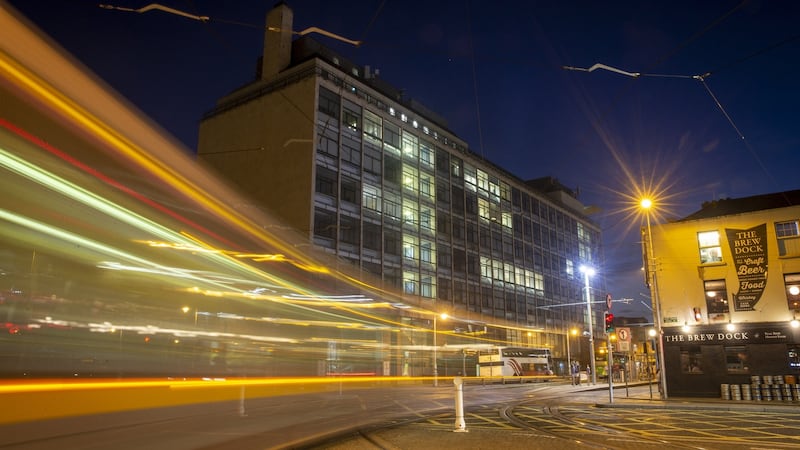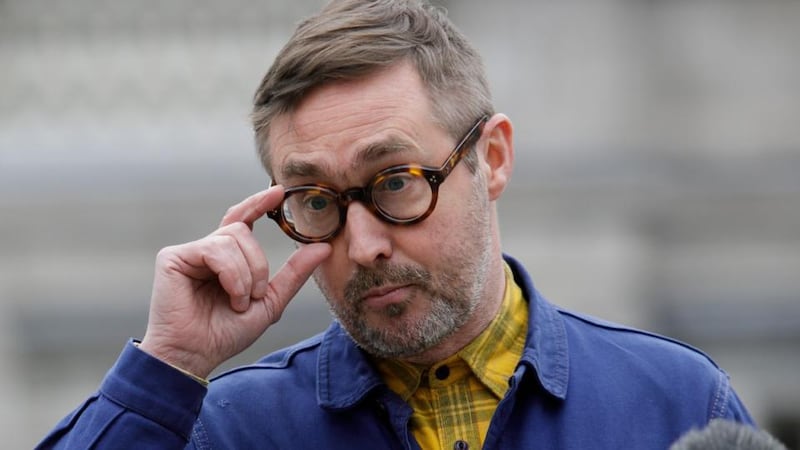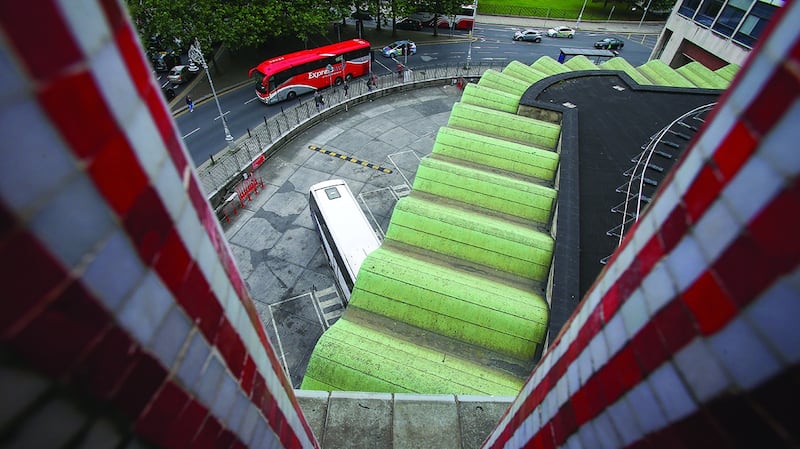It wasn't love at first sight. Eoin Ó Broin recalls passing Dublin's central bus station, Busáras, for 11 years on his journeys up and down to Belfast. "I had never looked up," he says. But something in the building caught his interest, and an Irish Architecture Foundation Open House tour in 2019 opened his eyes to the building's surprising wonders. Now the Sinn Féin TD and party spokesman for housing and heritage is a devoted fan. So much so that he has just published, with photographer Mal McCann, a lavishly illustrated book on the building.
Perhaps it’s no surprise. Conceived when the Irish Republic was still young, Busáras embodies the idealistic excitement of an emerging nation: the belief that doing things differently can change the world. Its design is founded on an egalitarianism and sense of socialism that seems like a no-brainer to cherish, and yet that somehow hasn’t managed to endure.
The larger building, of which Busáras is a part, is also named after Seán McDermott, one of the signatories to the 1916 Proclamation, and one of the 16 executed after the Easter Rising.
Ó Broin writes well; fluently, and poetically in places. He describes in detail how Áras Mhic Dhiarmada, designed by Michael Scott, incorporated work by Irish designers including Patrick Scott (no relation), who would later go on to become one of Ireland's most celebrated artists. Patrick Scott's mosaics adorn the building, and they, alongside Barney Heron's metal and woodwork, combine to shape a building in which beauty is given an importance and value, alongside the more utilitarian functions of the project. The design decisions and commissions declare that shelter from the rain while waiting for your bus is not enough: people deserve more.

McCann’s photographs capture this brilliantly. They also show neglect, dirt and decay. There are shots of the polished glowing wood-panelled interior offices, marquetry inlay, marble, mosaic and terrazzo, and skylights highlighted in gold. There are also images of missing mosaics, abandoned spaces, of a tent pitched in a doorway for overnight sleeping. Frustratingly for a book about architecture, form doesn’t follow function, and the image captions are housed at the back instead of alongside McCann’s shots and the well-researched historical pictures and original design drawings.
Despite its relative neglect, Busáras is a listed building, and a programme of restoration has recently been announced that includes making the building more accessible. Dermot Bannon Architects is one of the design teams involved.
While Ó Broin believes most Dubliners don't value Busáras as much as they might, it has in fact held an enduring fascination, being discovered, and rediscovered periodically over the years since its completion in 1953. Featuring prominently in the second volume of Ellen Rowley's More Than Concrete Blocks (2019), it was also the subject of Double Movement, an artwork by Gavin Murphy in 2017, at the Temple Bar Gallery, in which Murphy focused on the abandoned theatre, housed in the building's basement.
In Murphy’s words, Busáras was to have been “an all-encompassing civic building for all of Ireland. There were plans for a creche, and a barber’s…”. The theatre, which ran until 1995 as The Eblana, was to have been a screening room, so you could catch the news while waiting for your bus. There was also a nightclub on the top floor. That is now the canteen for the Department of Social Welfare.

Áras Mhic Dhiarmada was built at a time when public architecture mattered
Busáras was compromised from the start. What would become Europe’s first post-war office building was delayed and its design altered by problems with financing, politics and heated discordant debate. That’s what is so fascinating about the book. Beyond the important story of an intriguing building, Busáras turns, via Ó Broin’s writing, into a symbol, and from there to a metaphor. I think of Winston Churchill’s line – that “we shape our buildings; thereafter they shape us”. I’m not sure Ó Broin would approve of the source, but the quote is apt.
“Áras Mhic Dhiarmada was built at a time when public architecture mattered,” writes Ó Broin at the start of the book. “Those ideas, and the debates they provoked, have a relevance to us today.
“They offer important insights into the choices we have in front of us and where those choices might lead us in the future.”
Two hundred pages later, in a chapter entitled Philosophy, he compares Gandon’s Custom House, Busáras, and the IFSC (by Burke Kennedy Doyle): three neighbouring buildings whose architecture, through this reading, become a crossroads of civic choice. Do we dwell in a nostalgia for a past in which Georgian grandeur was founded on colonisation and inequality? Can we opt for idealistic egalitarianism? Or then there’s today’s neo liberal finance capitalism: in Ó Broin’s words, “a soul-less cosmopolitanism consistent with the desire of economic and political elites to dissolve any form of Irishness into a vacuous Europeanism, devoid of meaningful cultural or civic content”.

It is difficult to disagree and yet, as some politicians and pundits like to say, we are where we are. Looming over Ó Broin’s analysis of Busáras, a building that definitely deserves recognition and love, is the narrative that through an act of community and political will, we could return Ireland to an enduring republicanism in which all people are cherished and valued as equals. And yet the story of how the building came about, and its subsequent neglect would seem to suggest otherwise.
“We have never had proper social democracy in this State,” says Ó Broin, when I put the point to him. “At some point in the 1950s, that post-war generation trying to meet people’s needs in a democratic way just gets lost.” Then, he says, as Ireland got into the international markets, “the client is no longer the public [...] But Busáras exists. For all the exclusions, it happened,” he continues.
“What that tells you is that the pragmatism and the dogmatism doesn’t stop things. It constrains them, but it only constrains them to the degree people allow it to.” He agrees that “subconsciously this [Busáras] reflects my interest. It’s the interface between the possible and the desirable. I tend to think more is possible.”
The flourishes and beauty in Busáras, the cinema and the nightclub, were about the idea of pleasure as a public good, and not, as Ó Broin is keen to state, “pleasure as a route to profit […] Capitalism’s not going away, but that doesn’t mean we have to let it dictate the terms of everything,” he says, asking: “Where are the politicians in Government today, making the same arguments that we saw in that brief period?”
I suggest that politics is easier when it’s untested by the parameters of the possible. Using a bad analogy, I wonder if it’s a bit like going home and arguing with your mum about whether the kettle should be in a more convenient spot, and your mum saying it can’t, because this is where it’s always been. “Ahh,” he says with a smile. “When you’re in Government you’re the mum. You get to decide where the kettle goes.”
The Dignity of Everyday Life: Celebrating Michael Scott’s Busáras by Eoin Ó Broin and Mal McCann is published by Irish Academic Press, €35



















